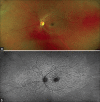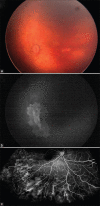Imaging the pediatric retina: An overview
- PMID: 33727440
- PMCID: PMC8012979
- DOI: 10.4103/ijo.IJO_1917_20
Imaging the pediatric retina: An overview
Abstract
Recent decade has seen a shift in the causes of childhood blinding diseases from anterior segment to retinal disease in both developed and developing countries. The common retinal disorders are retinopathy of prematurity and vitreoretinal infections in neonates, congenital anomalies in infants, and vascular retinopathies including type 1 diabetes, tumors, and inherited retinal diseases in children (up to 12 years). Retinal imaging helps in diagnosis, management, follow up and prognostication in all these disorders. These imaging modalities include fundus photography, fluorescein angiography, ultrasonography, retinal vascular and structural studies, and electrodiagnosis. Over the decades there has been tremendous advances both in design (compact, multifunctional, tele-consult capable) and technology (wide- and ultra-wide field and noninvasive retinal angiography). These new advances have application in most of the pediatric retinal diseases though at most times the designs of new devices have remained confined to use in adults. Poor patient cooperation and insufficient attention span in children demand careful crafting of the devices. The newer attempts of hand-held retinal diagnostic devices are welcome additions in this direction. While much has been done, there is still much to do in the coming years. One of the compelling and immediate needs is the pediatric version of optical coherence tomography angiography. These needs and demands would increase many folds in future. A sound policy could be the simultaneous development of adult and pediatric version of all ophthalmic diagnostic devices, coupled with capacity building of trained medical personnel.
Keywords: Newborn eye screening; pediatric retina; pediatric retinal diseases; retinal imaging.
Conflict of interest statement
None
Figures






References
-
- Position Paper- WHO archives- World Health Organization. [Last accessed 2020 Jun 03]. Available from: www.archives.who.int .
-
- Solebo AL, Teoh L, Rahi J. Epidemiology of blindness in children. Arch Dis Child. 2017;102:853–7. Erratum in: Arch Dis Child 2017;102:995. - PubMed
Publication types
MeSH terms
LinkOut - more resources
Full Text Sources
Other Literature Sources
Medical

